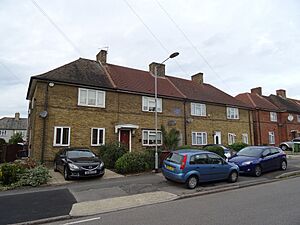Becontree facts for kids
Quick facts for kids Becontree |
|
|---|---|
 Houses built by the London County Council |
|
| Area | 4 sq mi (10 km2) |
| Population | 95,862 (2011 wards) |
| • Density | 23,966/sq mi (9,253/km2) |
| OS grid reference | TQ485855 |
| • Charing Cross | 11 mi (18 km) WSW |
| London borough | |
| Ceremonial county | Greater London |
| Region | |
| Country | England |
| Sovereign state | United Kingdom |
| Post town | DAGENHAM |
| Postcode district | RM8 |
| Dialling code | 020 |
| Police | Metropolitan |
| Fire | London |
| Ambulance | London |
| EU Parliament | London |
| UK Parliament |
|
| London Assembly | |
Becontree is a large area in the London Borough of Barking and Dagenham. It covers about 4 square miles (10 square kilometres). Becontree is located about 11 miles (18 kilometres) east of central London.
This area was built between 1921 and 1935. It became the biggest public housing estate in the world at that time. The London County Council built homes here for many people.
The estate's construction led to a big increase in population. This meant more services were needed, and local government changed. Becontree became part of Greater London in 1965.
Contents
History of Becontree
What's in a Name?
The Becontree estate gets its name from an old area called the Becontree Hundred. This name was first written down in the Domesday Book in 1086.
The name comes from Old English words. It means 'tree of a man named Beohha'. This special tree likely stood on Becontree Heath, near the estate's eastern edge.
Building the Estate
In 1919, a new law allowed the London County Council (LCC) to build homes outside of London. This was because there wasn't enough land in the city. The LCC decided to build 29,000 homes. About 24,000 of these were planned for Becontree.
Building started in 1921 and finished in 1935. The goal was to create "homes fit for heroes" for soldiers returning from World War I. Most of the land used was for growing vegetables before the houses were built.
| Estate name | Area | No of dwellings | Population 1938 | Population density |
|---|---|---|---|---|
| Pre 1914 | ||||
| Norbury | 11 | 218 | 867 | 19.8 per acre (49/ha) |
| Old Oak | 32 | 736 | 3519 | 23 per acre (57/ha) |
| Totterdown Fields | 39 | 1262 | - | 32.4 per acre (80/ha) |
| White Hart Lane Tower Gardens |
98 | 783 | 5936 | 8 per acre (20/ha) |
| 1919-1923 | ||||
| Becontree | 2770 | 25769 | 115652 | 9.3 per acre (23/ha) |
| Bellingham | 252 | 2673 | 12004 | 10.6 per acre (26/ha) |
| Castelnau | 51 | 644 | 2851 | 12.6 per acre (31/ha) |
| Roehampton Estate Dover House Road Estate |
147 | 1212 | 5383 | 8.2 per acre (20/ha) |
| 1924-1933 | ||||
| Downham | 600 | 7096 | 30032 | 11.8 per acre (29/ha) |
| Mottingham | 202 | 2337 | 9009 | 11.6 per acre (29/ha) |
| St Helier | 825 | 9068 | 39877 | 11 per acre (27/ha) |
| Watling | 386 | 4034 | 19110 | 10.5 per acre (26/ha) |
| Wormholt | 68 | 783 | 4078 | 11.5 per acre (28/ha) |
| 1934-1939 | ||||
| Chingford | 217 | 1540 | - | 7.1 per acre (18/ha) |
| Hanwell (Ealing) | 140 | 1587 | 6732 | 11.3 per acre (28/ha) |
| Headstone Lane | 142 | n.a | 5000 | |
| Kenmore Park | 58 | 654 | 2078 | 11.3 per acre (28/ha) |
| Thornhill (Royal Borough of Greenwich) |
21 | 380 | 1598 | 18.1 per acre (45/ha) |
| Whitefoot Lane (Downham) | 49 | n.a | n.a. | |
| Source: Yelling,1995 Rubinstein, 1991, Just like the country. |
The very first houses built are in Chittys Lane. You can spot them by a blue plaque on the wall. Building Becontree was a huge project. A special railway was even built just to bring in building materials. This railway connected to the main line and a wharf on the River Thames.
The project took longer than expected. The LCC hoped to build 24,000 homes by 1924, but only finished 3,000. The work continued in three stages until 1935.
| Stage | Years | Area | Homes Built | Total Homes |
|---|---|---|---|---|
| I | 1921–1924 | Ilford (some in Dagenham) | 3,000 | 3,000 |
| II | 1924–1930 | Dagenham (some in Ilford) | 15,000 | 18,000 |
| III | 1930–1935 | Barking | 7,736 | 25,736 |
| Extra | 1937 | 800 | 26,536 | |
| Heath Park | 1949–1951 | Dagenham | 600 | 27,136 |
The official completion of the estate was celebrated in 1935. By then, about 100,000 people lived in 26,000 homes. Even more homes were added later.
Who Lived Here First?
The LCC built Becontree to rehouse people from London's East End. Many of these families were moving from crowded areas. The first residents were mostly working-class families with steady jobs. They were often factory workers or bus drivers.
People were amazed to have indoor toilets and their own gardens. However, the houses could be cold in winter. Heating all the rooms was expensive for many families.
The LCC planted hedges along the pavements in front of every garden. Gardeners would trim them in spring and summer. There were even prizes for the best-kept gardens! This encouraged residents to look after their outdoor spaces.
Services for Residents
All houses had gas for cooking and heating. Most also had gas lighting, which was later changed to electricity by 1955. Water was supplied by the South Essex Waterworks Company.
The General Post Office decided that all homes on the estate would have a "Dagenham, Essex" postal address. This is why Becontree and Dagenham are often thought of as the same place.
At first, the LCC didn't think residents would need telephones. They believed it was a luxury for people in subsidized housing. But phone lines were eventually connected.
The original plan for Becontree included a town centre with shops. However, the LCC was mainly a landlord and couldn't control commercial development. So, a proper town centre wasn't built within the estate. Residents often used shops in nearby Barking and Ilford. Smaller groups of shops were built throughout the estate.
The estate was built without much car parking. It wasn't expected that residents would own cars. Over time, more garages were added for rent.
There were no railway stations directly inside the estate at first. But in 1926, a new stop called Gale Street Halt opened. In 1932, this became Becontree tube station. Another station, Heathway, was also added. These stations helped people travel around.
The number of school-aged children grew very quickly. More schools were needed. The first secondary school, "Green Lane," opened in 1923. It later became a primary school and was renamed "Henry Green" in 1953.
Jobs and Economy
When Becontree was first built, there were not many jobs or shops nearby. Residents had to travel to central London for work. This changed when big companies like May & Baker and Ford Dagenham opened factories close to the estate. These factories created many jobs for local people.
People and Population
According to the 2011 census, the largest group in Becontree ward was White British, making up 51% of residents. The second largest group was Black African, at 13%. Overall, about 41% of people identified as having a BAME background.
House prices in Becontree are among the lowest in Greater London. In 2014, the average house price in Becontree ward was £210,000.
Local Government
The Becontree estate is part of several local areas called wards. These wards are within the Barking and Dagenham London Borough Council.
Culture and Arts
East London has a long history of brass bands. The Becontree Brass Band was formed in 1981. It brought together several local bands.
The Dagenham Girl Pipers were started in 1930. They were the first all-female pipe band in the world! They are still performing today.
Education
The Becontree area has many schools. There are 26 primary schools and 13 secondary schools. Three of the secondary schools are free schools, and one is a University technical college called Elutec.
Getting Around (Transport)
Becontree tube station is served by London Buses Routes 62 and 145. Other bus routes connect the area to places like Dagenham Heathway, Barking, Ilford, and Romford. Chadwell Heath station is also nearby.
Famous People from Becontree
Many well-known people have lived in Becontree, including:
- Alf Ramsey (football manager)
- Terry Venables (football manager)
- Max Bygraves (entertainer)
- Dudley Moore (actor and musician)
- Sandie Shaw (singer)
- George Carey, who used to be the Archbishop of Canterbury



